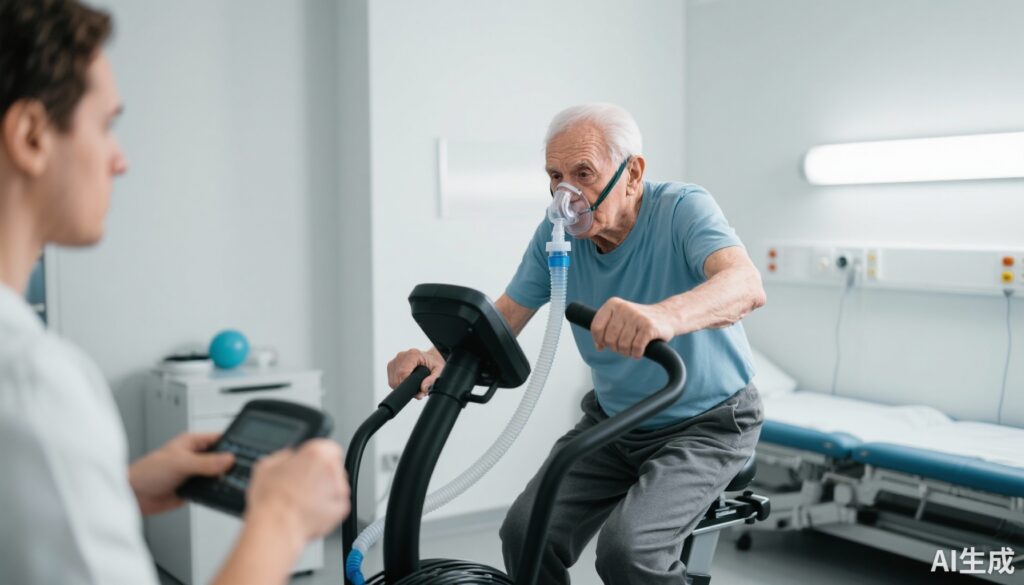Highlight
– High intensity interval training (HIIT), especially long-HIIT, is feasible and safe for COPD patients with chronic respiratory failure (CRF).
– Long-HIIT allowed greater progression of training workload with reduced dyspnoea and fatigue compared to short-HIIT and constant-load endurance training (ET).
– No serious adverse events occurred, and patient adherence and satisfaction were similar across all training modalities.
– Despite greater work volume progression in long-HIIT, clinical outcomes such as endurance time and six-minute walk distance did not significantly differ over the study period.
Study Background
Chronic obstructive pulmonary disease (COPD) with chronic respiratory failure (CRF) represents a subgroup of patients with severe disease burden characterized by progressive airflow limitation, ventilation/perfusion mismatch, and refractory hypoxemia. These patients often experience debilitating dyspnoea, fatigue, and reduced exercise capacity, contributing to diminished quality of life and high healthcare utilization. Pulmonary rehabilitation (PR) incorporating exercise training is a cornerstone of COPD management aimed at improving symptom burden and functional capacity. Traditional endurance training (ET) is well established but may be limited by exercise-induced dyspnoea and fatigue, particularly in patients with CRF receiving long-term oxygen therapy (LTOT).
High intensity interval training (HIIT) has emerged as a potentially more effective and tolerable exercise modality, alternating periods of high intensity work with recovery intervals, which may enhance physiological adaptations such as improved muscle oxidative capacity and ventilatory efficiency. However, evidence for HIIT, especially differing protocols, in COPD patients with severe CRF remains limited.
Study Design
Between August 2019 and June 2023, a prospective, randomized pilot trial was conducted to compare three ergometer-based exercise modalities in stable COPD patients with chronic respiratory failure. The study enrolled 60 participants (55 completed) undergoing 20 supervised sessions of exercise with oxygen supplementation, titrated individually to maintain SpO2 >91%. The interventions included:
– Constant-load endurance training (ET): 30 minutes at 60% of maximal workload (watts max).
– Long-High Intensity Interval Training (Long-HIIT): Cycles of 4 minutes at 75% max watts alternating with 4 minutes at 35% max watts for 32 minutes.
– Short-High Intensity Interval Training (Short-HIIT): Cycles of 30 seconds at 100% max watts alternating with 30 seconds at 50% max watts for 26 minutes.
Primary outcomes measured included progression of total work performed over sessions and percentage workload improvement from baseline. Secondary outcomes assessed were dyspnoea and fatigue (Borg scale), heart rate, oxygenation parameters (SpO2/FiO2), endurance time (Tlim), six-minute walk distance (6MWD), muscle strength measures (MIP and MEP), fall risk (BERG scale), fatigue severity (Fatigue Severity Scale), quality of life (COPD Assessment Test, Maugeri Respiratory Failure-26), activities of daily living (Glittre-ADL), and adverse events.
Key Findings
The trial found that all exercise modalities were safe, well tolerated, and acceptable to this severely disabled cohort using LTOT, with no serious adverse events or training intolerance leading to discontinuation.
At baseline, groups were comparable in demographics and clinical characteristics. The total work performed over the sessions was significantly greater in the Long-HIIT group compared to Short-HIIT but not significantly different from ET. Progression of work volume during training sessions was higher with HIIT modalities compared to ET (p=0.0489). Notably, patients in the Long-HIIT group experienced lower levels of dyspnoea (p=0.0174) and fatigue (p=0.0466) during training sessions than those in Short-HIIT or ET groups.
Heart rate and oxygenation dynamics (SpO2/FiO2) did not differ significantly between groups during the interventions. The variation in oxygen needs (FiO2) fluctuated individually, with no group differences, indicating adequate titration of supplemental oxygen during exercise.
Clinical outcome measures such as endurance time (Tlim) and six-minute walk distance (6MWD) improved in a majority of patients (76.36% for Tlim and 58.18% for 6MWD), but these improvements did not significantly differ between groups. Symptom scores for dyspnoea, fatigue, quality of life, and disease impact scales also showed no statistically significant intergroup differences post-intervention.
Attrition rates were low and not statistically different among groups, with high adherence and satisfaction reported, underscoring the feasibility of HIIT in this patient population.
Expert Commentary
This study addresses a critical gap in the literature by evaluating different HIIT modalities against standard endurance training in COPD patients with advanced disease complicated by chronic respiratory failure. The demonstration that long-HIIT allows greater workload progression with reduced symptom burden is compelling and mechanistically plausible given longer recovery intervals potentially enabling enhanced muscle oxygenation and reduced ventilatory strain.
Although the greater training volumes achieved with long-HIIT did not translate into statistically significant superiority in clinical functional outcomes over the short duration of the intervention, this pilot trial emphasizes safety, patient preference, and physiological tolerance as key components favoring the integration of long-HIIT in pulmonary rehabilitation protocols.
The sample size limits the power to detect definitive clinical efficacy differences, a recognized limitation of pilot exploratory studies. Future adequately powered randomized controlled trials with longer intervention periods are warranted to investigate the durability and magnitude of clinical benefits, elucidate mechanistic physiological differences between HIIT modalities, and explore their application across diverse respiratory pathologies beyond COPD with CRF.
Current guidelines acknowledge endurance training as fundamental for COPD rehabilitation, but emerging evidence suggests that tailored HIIT protocols may provide more efficient symptom control and exercise capacity improvements in select populations.
Conclusion
In conclusion, this prospective pilot trial provides important preliminary evidence that high intensity interval training, particularly the long-HIIT modality, is a safe, feasible, and acceptable exercise strategy for COPD patients with chronic respiratory failure on LTOT. Long-HIIT permits greater workload progression with less reported dyspnoea and fatigue compared to short-HIIT and traditional endurance training.
While clinical improvements in endurance and functional capacity were comparable across modalities during the study period, the potential for physiologic and symptomatic advantages with long-HIIT merits further investigation. Incorporating interval training within pulmonary rehabilitation may enhance exercise tolerance and quality of life in this vulnerable patient group if validated in larger, longer-term studies.
These findings support the consideration of personalized exercise prescriptions using HIIT formats to optimize the balance between efficacy and tolerability in advanced COPD rehabilitation programs.



